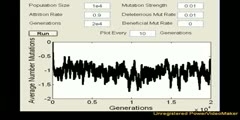How Fast Is Evolution?
Facts Of Evolution (Part 5): How Fast Is Evolution? --- Please subscribe to Science & Reason: • http://www.youtube.com/Best0fScience • http://www.youtube.com/ScienceMagazine • http://www.youtube.com/FFreeThinker --- EVOLUTION IS REAL SCIENCE: 1. Does The Evidence Support Evolution? http://www.youtube.com/watch?v=p1R8w_QEvEU 2. Vitamin C And Common Ancestry http://www.youtube.com/watch?v=SF2N2lbb3dk 3. Are We Descended From Viruses? http://www.youtube.com/watch?v=nIsWZCSMSSs 4. Does The Fossil Record Support Evolution? http://www.youtube.com/watch?v=QWVoXZPOCGk 5. Where Are The Transitional Forms? http://www.youtube.com/watch?v=kfTbrHg8KGQ FACTS OF EVOLUTION: 1. Introduction http://www.youtube.com/watch?v=43SskX-pEqA 2. Universal Common Descent http://www.youtube.com/watch?v=G0UGpcea8Zg 3. Good Design, Bad Design http://www.youtube.com/watch?v=1Mtr3Cum74A 4. Speciation And Extinction http://www.youtube.com/watch?v=T5kumHLiK4A 5. How Fast Is Evolution? http://www.youtube.com/watch?v=6XgeSi1EGkU --- Rates of Evolution Evolutionary rates can be measured quantitatively for a character within a lineage, and we begin by seeing how this is conventionally done. We then look at a large compilation of over 500 such measurements and ask whether fossil evolutionary rates fit in with the theory of population genetics. Punctuated equilibrium is an influential modern idea about evolutionary rates in fossils and we discuss the theory, how to test it, evidence for and against it, and its conceptual relation with the modern synthesis. The rate of evolution is a measurement of the change in an evolutionary lineage over time. The method for measuring the rate of evolution can be illustrated by work done by MacFadden on horse teeth: horse teeth are classic materials in the study of evolution. The rate of evolution is measured as follows: Suppose that a character has been measured at two times, t1 and t2 ; t1 and t2 are expressed as times before the present in millions of years. The time interval between the two samples can be written as:Dt = t1 - t2, which is 1 million years if t1 = 15.2 and t2 =14.2 The average value of the character is defined as x1 in the earlier sample and x2 in the later sample; we then take natural logarithms of x1 and x2 (the natural logarithm is the log to base e where e = 2.718, and it is symbolized by ln). The evolutionary rate (r) then is r = (ln(x2) - ln(x1)) / Dt The rate of evolution is measured in 'darwins'. Haldane defined a 'darwin' as a unit to measure evolutionary rates; one darwin is a change in the character by a factor of e in one million years. The formula above for r gives the rate in darwins provided that the time interval is in millions of years. • http://www.blackwellpublishing.com/ridley/tutorials/Rates_of_evolution1.asp • http://en.wikipedia.org/wiki/Darwin_%28unit%29 .
Channels: Others
Tags: evolution natural selection charles darwin biology common decent ancestry fossils transitional forms science evolutionary theories rates intelligent design speciation genetics haldane
Uploaded by: tubeman ( Send Message ) on 08-04-2010.
Duration: 2m 44s














